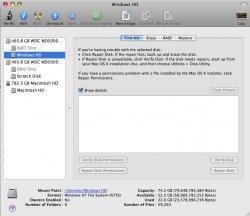According to everything I've read, this shouldn't have worked, but it seems that Win7's ability to boot from GPT volumes makes it possible.
I just replace the optical drive in my 2.66 MBP with a 2nd Seagate 500g drive and wanted to see what the OSX soft raid could do.
Long story short:
1. Each of the pair of disks contained a member of the larger OSX raid volume, plus a smaller partition intended for Windows.
2. The win-intended partitions stayed independent and formatted as FAT32.
3. Booted off of Win7 media. In setup, selected 1 of the FAT32 partitions and reformatted it NTFS. Installer accepted the partition as valid and installation proceeded normally and completed with Win7 as a valid boot option. OSX still works, of course.
Windows installer wouldn't accept the drives as a raid volume and although Vista is supposed to support GPT for data volumes, it wouldn't accept it as a system vol.
Don't bother with Bootcamp Setup Assistant. It simply says there's no valid disk and is of no help at all. This has to be done manually (which isn't exactly rocket surgery).
John
I just replace the optical drive in my 2.66 MBP with a 2nd Seagate 500g drive and wanted to see what the OSX soft raid could do.
Long story short:
1. Each of the pair of disks contained a member of the larger OSX raid volume, plus a smaller partition intended for Windows.
2. The win-intended partitions stayed independent and formatted as FAT32.
3. Booted off of Win7 media. In setup, selected 1 of the FAT32 partitions and reformatted it NTFS. Installer accepted the partition as valid and installation proceeded normally and completed with Win7 as a valid boot option. OSX still works, of course.
Windows installer wouldn't accept the drives as a raid volume and although Vista is supposed to support GPT for data volumes, it wouldn't accept it as a system vol.
Don't bother with Bootcamp Setup Assistant. It simply says there's no valid disk and is of no help at all. This has to be done manually (which isn't exactly rocket surgery).
John



